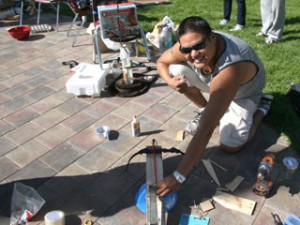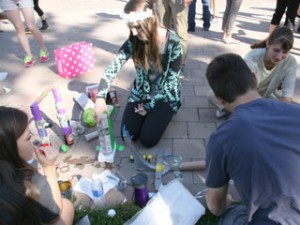
ARET student Michael Bontron takes aim during construction of his team’s Rube Goldberg machine.
On the first Friday of every fall semester, Architectural and Engineering Technology (ARET) faculty galvanize their students’ ingenuity with a team-building tradition. Second and third-year students share their expertise with first-years, just arrived on campus, to complete the ARET Design Challenge.
For 2014, students were asked to complete a simple task in a complicated fashion: construct a Rube Goldberg machine. Named for American cartoonist and inventor Rube Goldberg (1883–1970), the machine is defined as a contraption, invention, device or apparatus that is deliberately, unnecessarily over-engineered to perform a task, usually including a chain reaction.
“It’s a kinetic, dynamic sculpture,” said ARET faculty member Dale Parkes. The entire ARET student body was split into 15 teams, each required to produce one, interconnected piece of the machine. “They’re using pulleys, levers, maybe some gears. Judging is based on creativity, and it can’t stop or the team is disqualified.”

A toy car on a jump provides the momentum. Watch the video to see the whole machine in motion.
Faculty chose the paved circle between Old Main and the library as the bounds of the machine, keeping it to a tight ring where each team had approximately one square metre in which to work, and a 5 to 10 second time limit, so the complete, circular machine would run for about 2 minutes from start to finish.
“This is the first time we’re doing the Rube Goldberg as the challenge,” said third-year student Alice Hackman. The fact that the Design Challenge changes every year ensures senior students come with enthusiasm and stories from previous years, but no more prior experience than those who’ve been in the program for a week. Mixing first, second and third year students in each team makes for a great start-of-term icebreaker. “We had to confer with the other teams before and after,” she explained, noting the volleyball at their starting point and plastic crossbow bolt at the finish. Each team’s machine had to be triggered by the motion of the prior team, and wasn’t complete unless they successfully set the next team’s sequence in motion.
Her first-year teammate Michael Bontron tested the crossbow, intended to hit a racket at the next team’s starting line. “It’s a little bit of math and a lot of luck,” he said.
Materials were only limited to being recyclable or compostable, safe and portable—and as creative as possible. Students made use of conventional construction materials like pipe and plywood, as well as boxes, bottles, furniture, balls, and unique items like a children’s lunchbox, a deck of cards, a cat’s scratching post, a toy car and track, and a helium balloon.
“We learn to design on the fly,” said third-year student Luc Thibault, whose team utilized the lunch box and balloon.
Whether or not the balloon flies or the crossbow hits its mark, the students get a chance to improvise and work together in a way that sets the tone for the entire program.
Watch the end result of the ARET Design Challenge:
ARET students drew inspiration from OK Go’s Rube Goldberg machine in the video for “This Too Shall Pass”.
The ARET Rube Goldberg machine was also featured in CFJC TV’s coverage of the Back to School BBQ later that day.
View more videos on TRU’s YouTube channel.
Related Stories:
ARET Research—Q & A with Brandon Samoyloff

